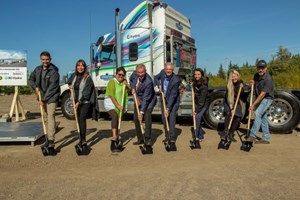News
Hydra Energy breaks ground on world’s largest H2 refueling station for heavy-duty trucks
Hydra Energy broke ground on the world’s largest H2 refueling station in Prince George, British Columbia. This marks the first project in the company’s Western Canadian H2 Corridor servicing B.C.- and Alberta-based heavy-duty trucks that have been converted to run on both H2 and diesel using Hydra’s zero-cost, co-combustion conversion kits. This includes Hydra’s first paying fleet customer, Prince George-based Dymin Mechanical, whose fleet will represent 12 of the 65 trucks the new station will support.
“What’s so important about designing and building our own H2 refueling station is that it solidifies a template of how to overcome the chicken and egg problem that has plagued the H2 sector. This Prince George station demonstrates that H2 can be provided at diesel parity without up-front capital costs for fleets,” said Hydra Energy Service Delivery Lead, Ilya Radetski.
Hydra’s CEO, Jessica Verhagen said, “We’re grateful for the support of the Prince George community since the region is a perfect place to demonstrate our proprietary H2 conversion technology due to its cold weather, challenging terrain, and the heavy payloads common in the area.”
The new station and H2 production will be located on five acres, will produce 3,250 kilograms of H2 a day, and can refuel as quickly as diesel and up to 24 Hydra-converted trucks each hour across four bays. The station’s low-carbon H2 is being produced from two on-site, 5-MW electrolyzers with electricity coming from BC Hydro, B.C.’s main electricity utility with 31 hydroelectric facilities throughout the province. Additional critical partners include energy project delivery expert, Solaris, and industrial construction specialist, PCL Construction, with project financing support coming from Hydra’s seed funders and non-dilutive government funding including the BC Ministry of Energy, Mines and Low Carbon Innovation - Part 3 Agreement.
“British Columbia’s clean electricity, abundant natural resources, and innovative companies have made us a world leader in the growing H2 sector. Companies like Hydra are demonstrating how H2 is helping us meet our CleanBC goals,” said Bruce Ralston, B.C. Minister of Energy, Mines and Low Carbon Innovation. “Hydra continues to crack the most difficult-to-decarbonize sector - heavy-duty trucking, which accounts for just over 1% of vehicles on Canadian roads but 30% of total GHG emissions. Not only does this home-grown innovation create jobs throughout the province, but Hydra’s approach also proves that it’s possible to reduce GHG emissions in a cost-effective way now.”
Building on the Minister’s GHG remarks, Solaris Principal Consultant, Avi Salh said, “We are excited to be working with Hydra as the project delivery experts, establishing H2 fueling for fleets in Western Canada. It takes a strong team and an integrated supply chain to establish novel projects like this. Reducing carbon footprint is a key focus for our organization and this project reflects our commitment to reducing greenhouse gas emissions.”
Hydra’s Prince George station will be operational early 2024. In the meantime, the company is also partnering with the Edmonton International Airport (EIA) to build a similar project on EIA land. This will service Hydra-converted trucks in the Edmonton region (like Hydra’s second fleet customer, VEXSL) marking the Eastern-most endpoint of Hydra’s Western Canadian H2 Corridor on Highway 16. Additionally, another station is being explored along the same highway in Port Edward/Prince Rupert located west of Prince George. Hydra is currently raising the balance of funding needed for the projects and will announce new investors once confirmed.


